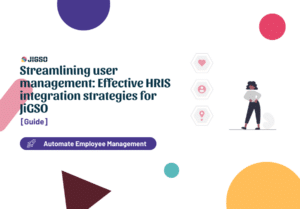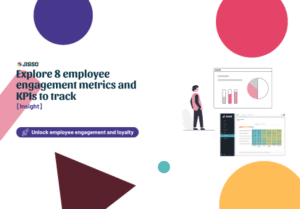In today’s competitive business landscape, organizations strive to enhance customer satisfaction and loyalty. However, it’s equally crucial to prioritize employee satisfaction and engagement, as they play a vital role in driving business success.
The Employee Net Promoter Score (eNPS) is a valuable metric that enables organizations to gauge employee loyalty and satisfaction levels. In this blog post, we will delve into the concept of eNPS, advantages & limitations, and alternative methods for measuring employee satisfaction.
Unleash the potential of eNPS to cultivate a thriving and motivated workforce that propels your organization towards success.
What is eNPS?
The Employee Net Promoter Score (eNPS) is a measurement that assesses employee loyalty and engagement by asking a single question: “On a scale of 0-10, how likely are you to recommend our organization as a great place to work?” Based on their responses, employees are segmented into three categories:
Promoters (score 9-10): Highly satisfied employees who actively promote the organization.
Passives (score 7-8): Moderately satisfied employees who may be prone to attrition.
Detractors (score 0-6): Disengaged employees who wouldn’t recommend the company and may have a negative impact on the organization.
To calculate the eNPS, subtract the percentage of Detractors from the percentage of Promoters. Note that the Passives are excluded from the calculation. The resulting score can range from -100 to +100.
eNPS = % Promoters – % Detractors
Thus, suppose a company has 100 employees. Out of these, 60 employees are Promoters, 25 employees are Passives, and 15 employees are Detractors. The eNPS would be calculated as follows:
eNPS = (Promoters – Detractors) / Total Respondents * 100
= (60 – 15) / 100 * 100
= 45%
Importance of measuring eNPS.
Organizations should measure eNPS for several reasons, including:
Predicting employee retention: Higher eNPS scores are often correlated with increased employee loyalty, reducing attrition rates and associated costs.
Strengthening employer branding: Positive eNPS scores can be leveraged to enhance the organization’s employer brand and attract top talent.
Aligning HR strategies: eNPS data helps HR teams align strategies to improve employee experience, engagement, and overall organizational performance.
- Identifying areas for improvement: Provided it is properly questioned, eNPS can provide insights into areas where employees may feel dissatisfied or disengaged, enabling organizations to take targeted actions to address issues.

The advantages of eNPS
Simplicity: The eNPS survey consists of a single question, making it easy to administer and analyze.
Benchmarking: eNPS allows organizations to compare their scores against industry benchmarks or other internal departments, facilitating performance evaluation and goal setting.
Increased participation rates: Responding to an eNPS question requires minimal time investment, encouraging a greater number of employees to actively participate.
Real-time measurement: eNPS can be conducted periodically, allowing organisation to track changes in employee satisfaction over time. In addition organisations can choose to divide the organisation in random samples and poll the population gradually.
- Familiarity: Satisfaction surveys have become a common aspect of our daily routines, and the majority of us are well-acquainted with their purpose and how to provide responses.
The limitations of eNPS
Because eNPS is so simple (which is nice), it lacks context. eNPS provides the “what” without the “why.” It functions similar to a smoke alarm, alerting you to a potential issue but not providing the exact location or cause. And that sense it more serves as a starting point for further investigation and exploration.
Lack of direction: eNPS provides a snapshot of employee perception within an organization but does not offer specific guidance on how to improve or move forward. It highlights the overall sentiment without delving into the underlying factors that contribute to the scores.
Lack of context: eNPS scores alone may lack the necessary context to fully understand the reasons behind employee sentiment. Without supplementary data or qualitative feedback, it can be challenging to pinpoint the specific areas that need improvement or to address underlying issues.
- Limited Scope: While eNPS gives an overview of employee loyalty and engagement, it may not capture the full complexity of the employee experience or encompass all aspects of workplace satisfaction. It focuses primarily on the likelihood of employees recommending the organization as a great place to work.
To overcome these limitations and gain actionable insights, we at JiGSO recommend augmenting the eNPS question with open-ended feedback. This, coupled with sentiment analysis and impact analysis, allows organisations to gather more comprehensive and meaningful data, identifying specific areas that require attention. By combining these additional metrics, organisations can gain a deeper understanding of employee sentiment and take targeted actions for improvement.
Other interesting reading

Boosting Employee Engagement: What, Why, and How
Employee engagement is a critical factor that affects the success of any organization. It refers to the level of commitment and emotional investment that an

What’s Team Culture & why it’s crucial for people engagement
What is Team Culture and How to Build It. Give employees purpose and effectively align teams to work toward achieving their goals
What is a good eNPS?
A good eNPS can vary depending on industry benchmarks and organizational context. Generally, a positive eNPS indicates a higher percentage of Promoters (employees highly satisfied and likely to promote the organization) compared to Detractors (disengaged employees who may have a negative impact). While there is no universally defined threshold for a “good” eNPS, organizations typically aim for positive scores above zero.
It’s important to note that eNPS interpretation should consider industry standards, organizational goals, and trends over time rather than focusing solely on a specific number. Regular monitoring and improvement efforts are key to continuously enhancing employee satisfaction and engagement.
Leveraging eNPS data for improvement
Once an organisation has measured eNPS across different departments, they can take the following steps:
- Identify trends and patterns: Analyze eNPS scores to identify patterns across departments, teams, or locations that require attention.
- Address key concerns: Use open-ended feedback to identify specific issues affecting employee satisfaction and engagement, and take targeted actions to address them.
- Share insights and foster dialogue: Communicate eNPS results throughout the organization, encouraging open discussions and collaborative problem-solving.
- Monitor progress: Conduct periodic eNPS surveys to track progress and evaluate the impact of implemented initiatives.
Alternatives to eNPS
While eNPS is a widely used metric, alternative approaches to measuring employee satisfaction and engagement include:
- eSAT (Employee Satisfaction Survey): A comprehensive survey that covers multiple aspects of employee satisfaction, providing a more detailed understanding of specific areas for improvement.
- Pulse Surveys: Short, frequent surveys conducted at regular intervals to capture real-time feedback and track changes in employee sentiment.
- Employee Engagement Surveys: Assessing various factors contributing to employee engagement, such as work-life balance, career growth opportunities, and recognition programs.
- Stay interviews and exit interviews: Conducting structured interviews with current employees (stay interviews) or departing employees (exit interviews) to understand their experiences, identify factors contributing to satisfaction or dissatisfaction, and gather suggestions for improvement.
Conclusion: Measuring employee satisfaction and engagement is essential for organisations striving to create a positive work culture and drive business success. The eNPS offers a simple and effective way to gauge employee loyalty, identify areas for improvement, and foster a more engaged workforce. While eNPS has its advantages and disadvantages, it serves as a valuable tool when combined with other metrics and qualitative feedback to gain a comprehensive understanding of employee sentiment.



